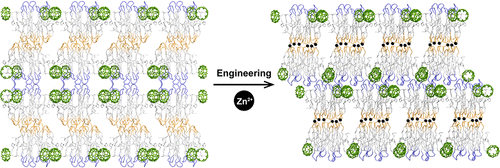当前位置:
X-MOL 学术
›
Cryst. Growth Des.
›
论文详情
Our official English website, www.x-mol.net, welcomes your
feedback! (Note: you will need to create a separate account there.)
Metal-Mediated Protein–Cucurbituril Crystalline Architectures
Crystal Growth & Design ( IF 3.2 ) Pub Date : 2020-08-25 , DOI: 10.1021/acs.cgd.0c01023 Francesca Guagnini 1 , Sylvain Engilberge 1 , Ronan J. Flood 1 , Kiefer O. Ramberg 1 , Peter B. Crowley 1
Crystal Growth & Design ( IF 3.2 ) Pub Date : 2020-08-25 , DOI: 10.1021/acs.cgd.0c01023 Francesca Guagnini 1 , Sylvain Engilberge 1 , Ronan J. Flood 1 , Kiefer O. Ramberg 1 , Peter B. Crowley 1
Affiliation

|
Controlled protein assembly is an enabling technology, for example, in the bottom-up fabrication of biomaterials. This paper describes the assembly of a β-propeller protein using two orthogonal interaction modes. Previously, protein assembly was directed by metal coordination or macrocycle complexation. Here, we demonstrate the combination of metal coordination and macrocycle complexation for controlled assembly. An established protein–cucurbit[7]uril (Q7) assembly, which relies on trimeric Q7 clusters, was modified by the inclusion of metal-binding sites in the protein. The application of zinc–histidine coordination to tune the Q7-induced assembly resulted in metallo-bioorganic crystalline architectures. The relative arrangement of the protein–Q7 layers was reorganized by the zinc bridging ions. One structure resulted in a different type of protein–Q7 packing that involves Q7 dimers. Apparently, Q7 is a versatile molecular glue that can be combined with metal-mediated protein assembly. This dual strategy expands significantly the toolkit for engineered assembly.
中文翻译:

金属介导的蛋白质-葫芦素晶体结构
受控的蛋白质组装是一种使能技术,例如在生物材料的自下而上制造中。本文描述了使用两种正交相互作用模式组装β-螺旋桨蛋白的过程。以前,蛋白质组装是通过金属配位或大环络合来指导的。在这里,我们演示了金属配位和大环络合物相结合的可控组装。依赖于三聚体Q7簇的已建立的蛋白质-葫芦[7] uril(Q7)装配体通过在蛋白质中包含金属结合位点而得到修饰。锌-组氨酸配位的应用可调节Q7诱导的装配,从而形成了金属-生物有机晶体结构。蛋白质的相对排列Q7层通过锌桥联离子重组。一体式结构导致了不同类型的蛋白质的Q7包装涉及Q7二聚体。显然,Q7是一种通用的分子胶,可以与金属介导的蛋白质组装结合使用。这种双重策略极大地扩展了工程组装的工具包。
更新日期:2020-10-07
中文翻译:

金属介导的蛋白质-葫芦素晶体结构
受控的蛋白质组装是一种使能技术,例如在生物材料的自下而上制造中。本文描述了使用两种正交相互作用模式组装β-螺旋桨蛋白的过程。以前,蛋白质组装是通过金属配位或大环络合来指导的。在这里,我们演示了金属配位和大环络合物相结合的可控组装。依赖于三聚体Q7簇的已建立的蛋白质-葫芦[7] uril(Q7)装配体通过在蛋白质中包含金属结合位点而得到修饰。锌-组氨酸配位的应用可调节Q7诱导的装配,从而形成了金属-生物有机晶体结构。蛋白质的相对排列Q7层通过锌桥联离子重组。一体式结构导致了不同类型的蛋白质的Q7包装涉及Q7二聚体。显然,Q7是一种通用的分子胶,可以与金属介导的蛋白质组装结合使用。这种双重策略极大地扩展了工程组装的工具包。











































 京公网安备 11010802027423号
京公网安备 11010802027423号